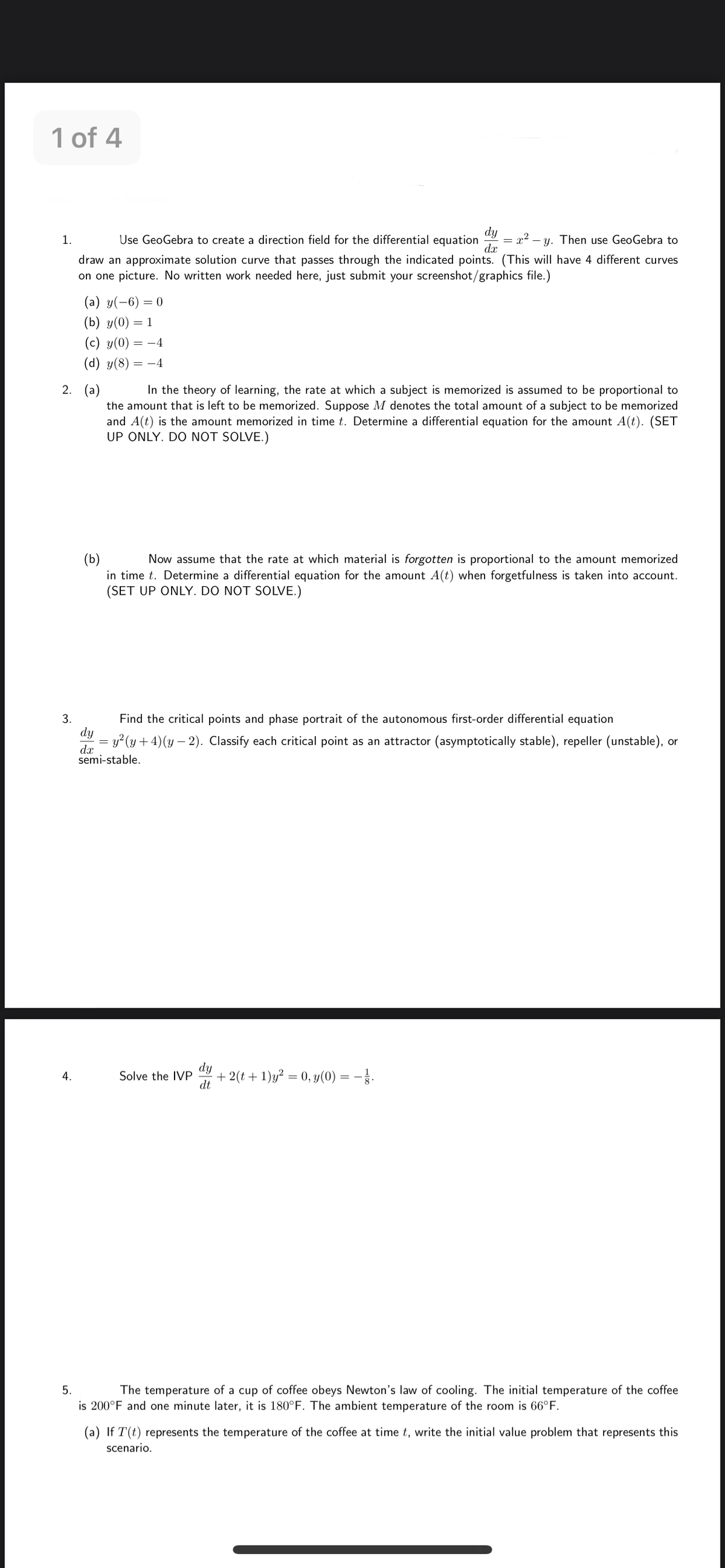3. Find the critical points and phase portrait of the autonomous first-order differential equation = y? (y + 4)(y – 2). Classify each critical point as an attractor (asymptotically stable), repeller (unstable), or dx semi-stable.
3. Find the critical points and phase portrait of the autonomous first-order differential equation = y? (y + 4)(y – 2). Classify each critical point as an attractor (asymptotically stable), repeller (unstable), or dx semi-stable.
Advanced Engineering Mathematics
10th Edition
ISBN:9780470458365
Author:Erwin Kreyszig
Publisher:Erwin Kreyszig
Chapter2: Second-order Linear Odes
Section: Chapter Questions
Problem 1RQ
Related questions
Question
Answer question 3 pls

Transcribed Image Text:1 of 4
dy
Use GeoGebra to create a direction field for the differential equation
dx
1.
- y. Then use GeoGebra to
draw an approximate solution curve that passes through the indicated points. (This will have 4 different curves
on one picture. No written work needed here, just submit your screenshot/graphics file.)
(а) у(—6) — 0
(b) y(0) :
= 1
(c) y(0)
= -4
(d) y(8)
= -4
2. (а)
In the theory of learning, the rate at which a subject is memorized is assumed to be proportional to
the amount that is left to be memorized. Suppose M denotes the total amount of a subject to be memorized
and A(t) is the amount memorized in time t. Determine a differential equation for the amount A(t). (SET
UP ONLY. DO NOT SOLVE.)
(b)
in time t. Determine a differential equation for the amount A(t) when forgetfulness is taken into account.
(SET UP ONLY. DO NOT SOLVE.)
Now assume that the rate at which material is forgotten is proportional to the amount memorized
3.
Find the critical points and phase portrait of the autonomous first-order differential equation
dy
= y? (y+ 4)(y – 2). Classify each critical point as an attractor (asymptotically stable), repeller (unstable), or
dx
semi-stable.
dy
+ 2(t + 1)y² = 0, y(0) = – §.
dt
4.
Solve the IVP
5.
The temperature of a cup of coffee obeys Newton's law of cooling. The initial temperature of the coffee
is 200°F and one minute later, it is 180°F. The ambient temperature of the room is 66°F.
(a) If T(t) represents the temperature of the coffee at time t, write the initial value problem that represents this
scenario.
Expert Solution
This question has been solved!
Explore an expertly crafted, step-by-step solution for a thorough understanding of key concepts.
This is a popular solution!
Trending now
This is a popular solution!
Step by step
Solved in 4 steps with 4 images

Recommended textbooks for you

Advanced Engineering Mathematics
Advanced Math
ISBN:
9780470458365
Author:
Erwin Kreyszig
Publisher:
Wiley, John & Sons, Incorporated

Numerical Methods for Engineers
Advanced Math
ISBN:
9780073397924
Author:
Steven C. Chapra Dr., Raymond P. Canale
Publisher:
McGraw-Hill Education

Introductory Mathematics for Engineering Applicat…
Advanced Math
ISBN:
9781118141809
Author:
Nathan Klingbeil
Publisher:
WILEY

Advanced Engineering Mathematics
Advanced Math
ISBN:
9780470458365
Author:
Erwin Kreyszig
Publisher:
Wiley, John & Sons, Incorporated

Numerical Methods for Engineers
Advanced Math
ISBN:
9780073397924
Author:
Steven C. Chapra Dr., Raymond P. Canale
Publisher:
McGraw-Hill Education

Introductory Mathematics for Engineering Applicat…
Advanced Math
ISBN:
9781118141809
Author:
Nathan Klingbeil
Publisher:
WILEY

Mathematics For Machine Technology
Advanced Math
ISBN:
9781337798310
Author:
Peterson, John.
Publisher:
Cengage Learning,

